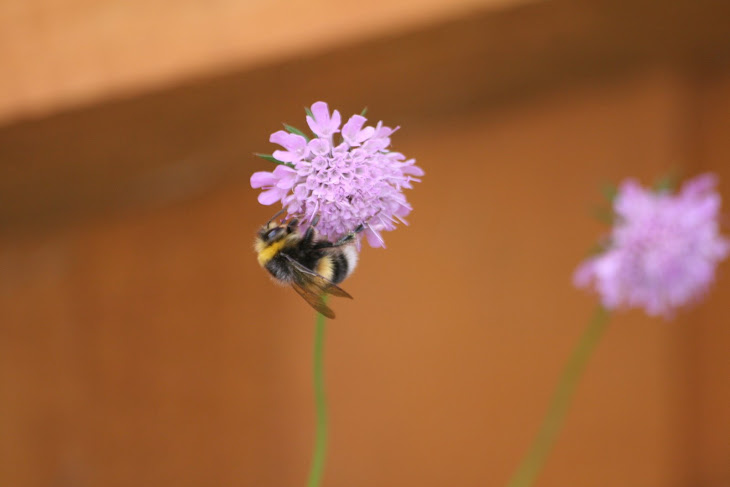It is probably a coincidence that the University of Bath should upload a podcast on the topic of declining bee populations soon after the
Sunday Times article on the same topic, since Stuart Roberts, research fellow at the University of Reading, gave his talk in autumn 2008, but the themes overlap and illustrate the concerns researchers have about bee populations. Listening to a podcast is not the same as being there, since you have to imagine what the slides would be telling you, but if you want a good introduction to this debate this podcast is well worth a listen.
Stuart Roberts: Bee decline - Countdown to catastrophe?IntroductionThere is more to 'bees' than honey. Bees are in the insect order Hymenoptera, diverging from the general insect tree at about the time of the Permian Carboniferous: 300 million years ago. The order includes sawflies, parasitic wasps, social wasps and bees. There is one species of honey bee, (Apis mellifera). But if you were to download bee clip art from the internet, you would be more likely to get a version of a bumblebee. There have been up to 25 species in the United Kingdom, though some have been so rare as to be almost invisible. There is also a group of 240 other bees, nesting underground or in old snail shells. Some bees live a parasitic life, relying on a host social bee to do all the foraging for them.
Worldwide, you can find maybe 9 species of honey bee (depending on where the species lines get drawn). There are around 250 species of bumblebee and 19,500 other bees, including some spectacular examples.
Bee declineBee declines have been reported in various sources, like major newspapers. Some doubts have been raised, but these have tended to focus researcher's interests in collecting evidence to demonstrate that such declines are taking place. How can we separate the facts from the widely held beliefs? Is the Honey Bee industry able to provide reliable evidence on whether such declines are taking place. Surprisingly, this is not the case as data on bee-keeping activiies has not been consistently collected. Germay has the best data-collection as this is integrated with the trading standards process (rather than the inland revenue). Sweden also sets a high standard. There are long term trends involved, but it is not clear whether the number of colonies being the same as in 1920 is evidence of stability or decline. Evidence based on regitration of bee-keepers can also be interpreted as showing the popularity and benefits of registering, rather than proving an increse in bee-keeping itself. A paper on european wide honey bee statistics may be published soonin the
Apidologie journal. Overall there does seem to be a decline in honey bees across Europe.
Solitary and Bumble BeesAmateur generated data is available from Britain and the Netherlands where it has been collected by societies like the
Bees, Ants and Wasps Recording Society. 1980 can be chosen as a cut-off point for comparisons. In the UK there are more 10 X 10 kilomere squares showing a decline in the richness of species to be found than where the position is stable or increasing. The situation in the Netherlands is similar. Specialist bees are declining more rapidly than generalist foragers. 'Slow' species , with one cycle per year, were subjewct to greater declines than those which manage 2 cycles per year. These results were published in Science a copuple of years ago:
Biesmeijer (2006).Parallel declines in pollinators and insect-pollinated plants in Britain and the Netherlands. Science [0036-8075] vol:313 iss:5785 pg:351 -354http://dx.doi.org/10.1126/science.1127863There is a decline, most species and involved and the winners are outnumbered by the losers. The decline seems to be happening whereever researchers have been able to look.
What is driving the decline?Some sugestions of the causes for the declines may not have much evidence behind them: mobile phone masts, car exhausts, high-tension electricity cables. More plausible causes may include the US practice of shipping bees from one coast to another wherever people are prepared to pay for pollination services; large field monocultures; pesticides and herbicides (like neo-nicotinoids); parasites like varroa mites. Colonies can collapse under such presures, but not all colonies lost are a result of 'Colony Collapse Disorder'. 45% of european bee species appear on a variety of threat lists. In the UK, as a typical country, the main drivers seem to be:
- habitat loss;
- starting off a a rare species;
- changes in host-plant dynamics (or in hosts for paracitic bees);
- climate change.
Who cares?
Bee keepers, farmers, anyone who likes strawberries: even ice-cream makers Haagen-Daz now sponsors bee research as its flavourings are all bee pollinated.
What are the impacts?
Insect pollination worldwide is worth 153 billion euros per year. 84% of european crop species rely on insect pollination. Agricultural industries would be hard hit. Flowering plants would start to be threatened.
There are things that people can do individually in their gardens and governments can achieve by re-focussing policies.
We may not yet have reached catastrophe, yet. At least the situation is being recognised and that is an important start.






